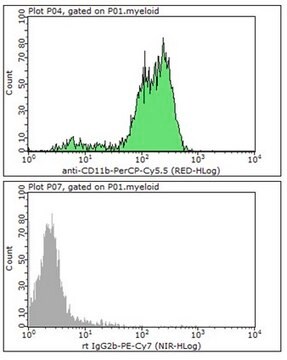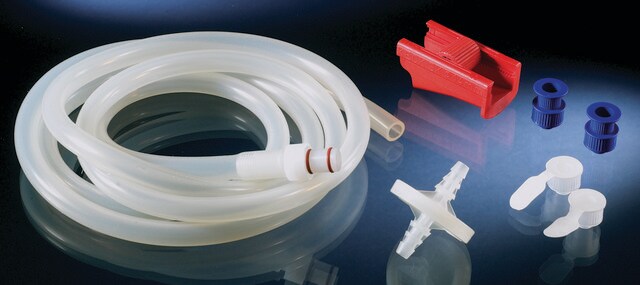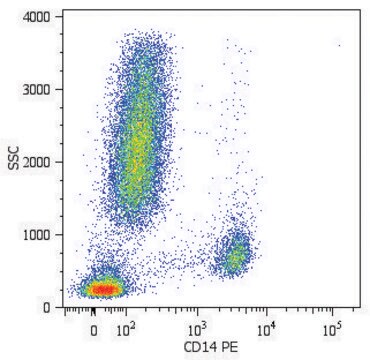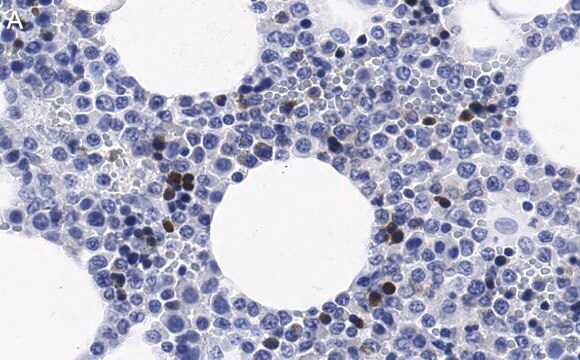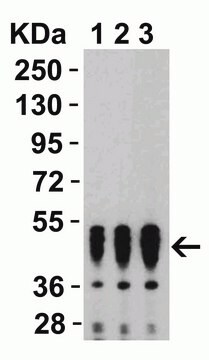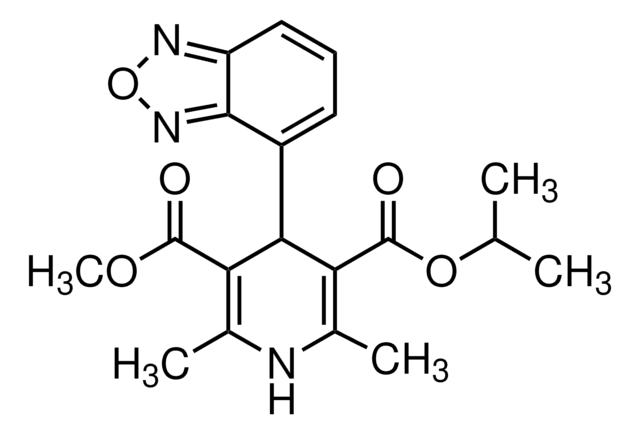Description générale
CD11b is an α/β heterodimeric glycoprotein. It belongs to the β2 integrin family and also referred as Mac-1, CR3, MO-1, and C3bi receptor.
Monoclonal Anti-Human CD11b antibody (mouse IgG1 isotype) is derived from the hybridoma produced by the fusion of mouse myeloma cells and splenocytes from BALB/c mice immunized with the human monocytes. CD11b is expressed on the surface of circulating monocytes, granulocytes, and certain natural killer (NK) cells. It is also present on subsets of macrophages. CD11b is present in subcellular granules and is translocated to the surface after activation.
Spécificité
Recognizes the CD11b α-chain of the human CD11b/CD18 complex. The antibody is useful for studies on cell adhesion and migration and for the detection of leukocyte adhesion deficiencies. It may be used to stain acetone-fixed cryostat sections or cell preparations. The epitope recognized by the antibody is formalin sensitive.
2nd Workshop: code no. M104
3rd Workshop: code no. 202 and 238
4th Workshop: code no. M47
Immunogène
human monocytes.
Application
Anti-CD11b-FITC antibody is suitable for flow cytometric analysis of CD11b expression in RA-induced differentiation of human promyelocytic leukemia cells. It is also suitable for flow cytometric analysis of spleen cells to study the beneficial effects of dietary consumption of n-3 polyunsaturated fatty acids (PUFA) and two selective estrogen receptor modulator (SERM) derivatives.
Actions biochimiques/physiologiques
Anti-CD11b-FITC antibody is expressed on the surface of circulating monocytes, granulocytes, and certain NK cells. It is also present on subsets of macrophages and in subcellular granules of granulocytes. Upon activation, it translocates to the surface. It forms a CD11b/CD18 complex to participate in a variety of cell-cell and cell-substrate interactions such as attachment and phagocytosis of particles coated with C3bi by granulocytes and macrophages and phagocytosis of opsonized pathogens. It also plays a role in the initiation of a coagulation protease cascade and in cell migration mechanisms.
Surface expression of cluster of differentiation molecule CD11b/CD18 is capable of both functional and quantitative upregulation. CD11b/CD18 functions as a receptor for C3bi, clotting factor X, fibrinogen, and intercellular adhesion molecule 1 (ICAM-1). CD11b/CD18 is involved in a variety of cell-cell and cell-substrate interactions such as attachment and phagocytosis of particles coated with complement receptor type 3 (C3bi) by granulocytes and macrophages and phagocytosis of opsonized pathogens. It also plays a role in the initiation of a coagulation protease cascade and in cell migration mechanisms. The endothelial cell counter-receptor for CD11b/CD18 is ICAM-1. Monoclonal Anti-Human CD11b can be used to stain acetone-fixed cryostat sections or cell preparations. The epitope recognized by the antibody is formalin sensitive.
Description de la cible
CD11b α-chain of the human CD11b/CD18 complex is an α/β heterodimeric glycoprotein which belongs to the β2 integrin family. It is also known as Mac-1, CR3, MO-1 and C3bi receptor. CD11b is expressed on the surface of circulating monocytes, granulocytes and certain NK cells and is also present in subsets of macrophages. It functions as a receptor for iC3b, clotting factor X, fibrinogen and ICAM-1.
Forme physique
Solution in 0.01 M phosphate buffered saline, pH 7.4, containing 1% bovine serum albumin and 15 mM sodium azide.
Notes préparatoires
Prepared by conjugation to fluorescein isothiocyanate isomer I (FITC). This green dye is efficiently excited at 495 nm and emits at 525 nm.
Clause de non-responsabilité
Unless otherwise stated in our catalog or other company documentation accompanying the product(s), our products are intended for research use only and are not to be used for any other purpose, which includes but is not limited to, unauthorized commercial uses, in vitro diagnostic uses, ex vivo or in vivo therapeutic uses or any type of consumption or application to humans or animals.
